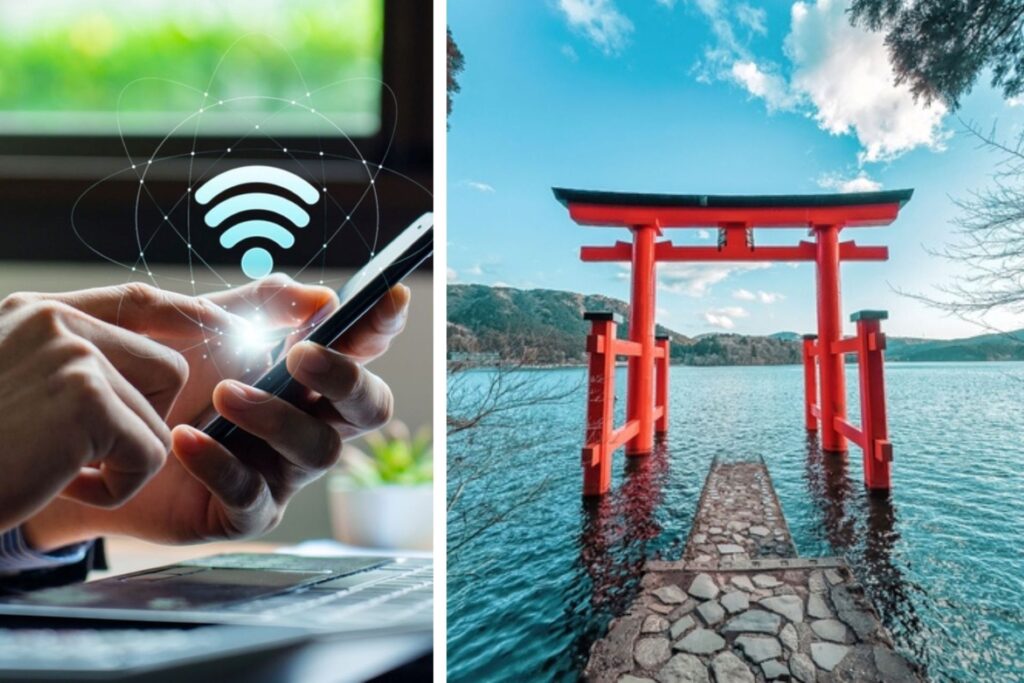Ninja WIFI vs Japan Wireless: Advantages & disadvantages
When we compare Ninja WiFi vs. Japan Wireless, we see similarities, but also important differences between the two. Want to know more?
Did you know that finding free public WiFi in Japan is surprisingly difficult? There are several reasons behind Japan’s limited public WiFi. For starters, most locals avoid using free public WiFi to protect themselves from hacking and cyber threats. Naturally, with low demand, there’s also limited supply of open networks. That’s why if you’re planning to travel to this amazing country, you should pack a pocket WiFi. It’s a small device that lets you stay connected on all your devices while exploring. Sounds like the perfect solution, right? But which one should you choose? With so many options on the market, it can be overwhelming to find the right one. To make your decision easier, here’s a detailed comparison of two popular services used by travellers heading to Japan: Ninja WiFi vs Japan Wireless.
Both options are great solutions for staying connected in the Land of the Rising Sun. But which one offers better pricing? Do they provide the same coverage? And what are the key differences? Keep reading—because as you move through this article, you’ll discover everything each service has to offer.
Comparing Ninja WiFi vs Japan Wireless
We’ll gradually break down the key differences between Ninja WiFi vs Japan Wireless. But first, here’s a side-by-side comparison to help you clearly see their main similarities and differences.
| Japan Wireless WiFi | Ninja WiFi | |
|---|---|---|
| Type of service | Pocket WiFi (portable WiFi device) | Pocket WiFi (portable WiFi device) |
| Device required | Yes, you need to rent a device. | Yes, you need to rent a device. |
| Coverage | 99% of Japanese territory | 99% of Japanese territory |
| Connection | Connects to the local network using a physical SIM | Connects to the local mobile network |
| Speed | 4G LTE from SoftBank | 4G LTE from SoftBank / 5G from Docomo |
| Data plans | Unlimited data plans | Limited and unlimited data plans |
| Connected devices | Between 5–10 devices, depending on the pocket WiFi model | Up to 10 devices |
| Battery | 18-20 hours of battery life | 8-12 hours of battery life |
| Set-up | Requires set-up, but it’s simple and quick | Easy – just turn on the device and enter a password |
| Availability | To hotels, airport post offices, homes in Japan, and commercial offices | To hotels, company counters at airports, dedicated lockers, or home addresses in Japan |
| Lowest data plan price | From $3.90/day | From $2.95/day |
| Return | Simple and fast. Drop it in any mailbox using the prepaid return envelope Simple and fast. | Simple and fast. Drop it in any mailbox using the prepaid return envelope Simple and fast. |
| Technical support | In English. By email or phone call. | Language not specified. During business hours via WhatsApp, email or phone call |
Comparing Ninja WiFi vs Japan Wireless
At first glance, there aren’t major differences between these two services. Both companies offer pocket WiFi rental for Japan and follow a similar process: You book the device online, choose your rental period, pay, collect it, and return it once your trip ends.
The main differences lie in: The price of data plans, the device rental fee, the battery life, the number of devices you can connect at once and the quality of customer support. Next, we’ll take a closer look at each detail so you can decide which pocket WiFi suits you best.
What’s Ninja WiFi?
Before diving deeper into this comparison between Ninja WiFi vs Japan Wireless, let’s take a closer look at today’s contenders.
As you may already know, Ninja WiFi is a mobile router rental service operated by Vision Inc, headquartered in Shinjuku, Tokyo. Once you arrive in Japan, you can pick up your pocket WiFi and start using it to stay connected on all your devices. This way, you avoid the hassle of hunting for free public WiFi in cafés or shopping centres.
Ninja WiFi offers two preconfigured pocket WiFi models, ready to use straight out of the box. When renting a device, you’ll need to select a data package and, if needed, add optional extras provided by the company. Ninja WiFi plans offer unlimited data, but speed restrictions apply once you exceed the daily usage limit. You won’t lose connection, but your user experience may be affected.
What’s Japan Wireless WiFi?
Japan Wireless WiFi is another portable internet service for Japan, and it works just like Ninja WiFi—through the rental of a pocket WiFi device. The company behind the service operates under the name Inbound Platform Corp., also based in Tokyo. With over ten years of experience, it has become one of the most popular choices among travellers heading to Japan.
Japan Wireless offers two different router models—Business WiFi and Premium WiFi—along with short-term and long-term data packages. This makes it easy to pick a plan that fits your travel needs and preferences.
Ninja WiFi vs Japan Wireless: Which one offers better plans and prices?
Since both services offer the same type of product, the real competition lies in the cost of their data plans. And that’s no small detail—especially if you’re a traveller looking for reliable internet without spending half your budget on it. Let’s not forget you’re heading to Japan, a country full of exciting things to discover. You’ll likely want to save money for experiences, like cultural tours, delicious food, or entry to ancient temples—not spend it all on pocket WiFi rental.
To help you make a smart, budget-friendly choice, here’s a side-by-side price comparison table for Ninja WiFi vs Japan Wireless:
| Ninja WiFi | Japan Wireless WiFi | |
|---|---|---|
| Pocket WiFi models | K4 (SoftBank 4G LTE) U50 Unlimited (Docomo 5G) | Business WiFi Premium WiFi |
| Extras included in the rental price | Not available All extras come at an additional cost: WiFi insurance: $2.95/day – €2.81/day Portable Backup Battery $0.74/day – €0.71/day 4-Port USB AC adapter: $0.74/day – €0.71/day Plug adapter: $0.74/day – €0.71/day | Second power bank USB cable and plug-in AC adapter Prepaid return envelope with return address Travel pouch |
| Data plans | K4 Model (SoftBank 4G LTE): Unlimited Plan – 1 GB per day: $2.95/day – €2.81/day Unlimited plan – 3 GB per day: $5.16/day – €4.92/day Unlimited plan – 5 GB per day: $7.37/day – €7.02/day Unlimited Plan – 10 GB per day: $8.84/day – €8.42/day Infinite unlimited plan: $13.13/day – €12.61/day Please note: For all plans except the truly unlimited one, speed will be reduced if you exceed the daily data allowance. U50 Unlimited (Docomo 5G Model) Unlimited 5G Plan: $14.59/day – €14.02/day | Short-term plans (28-day rental): Business WiFi: $3.90/day – €3.75/day Premium WiFi: $4.10/day – €3.94/day Long-term plan 3 months: $132 – €126.82 6 months: $240 – €230.58 12 months: $446 – €428.49 All plans come with unlimited data. |
Price Ninja WiFi vs Japan Wireless
Let’s break down what we’ve seen in the comparison table. Both companies offer two pocket WiFi models. When renting either one, you’ll need to select a data plan, which determines the total cost. With Japan Wireless, you can choose between short-term and long-term plans for both router models. Meanwhile, Ninja WiFi works differently. If you go for the U50 model, your only option is an unlimited 5G data plan via the Docomo network. If you choose the K4 model, you’ll have more flexibility—pick a daily data cap plan or a truly unlimited 4G LTE plan on the SoftBank network.
Which one is the better deal? The U50 model from Ninja WiFi comes at a high cost, even though it offers unlimited data and access to 5G. We only recommend this option for: Digital nomads who live and work in Japan or groups of travellers who can split the rental cost
We believe Japan Wireless offers better overall pricing, especially since all of its plans include unlimited data. With either plan, you’ll connect to the SoftBank 4G LTE network, with speeds depending on the device model: Business WiFi: Up to 120 Mbps download, Premium WiFi: up to 187 Mbps download Of course, real-world speeds can vary due to factors like network congestion. According to traveller reviews, download speeds typically range from 50 to 150 Mbps, while upload speeds average 20 to 50 Mbps.
Important: If you are a frequent traveler and want to stay connected without worrying about expensive roaming or looking for a new SIM at every destination, Holafly’s subscription plans are for you. With a single eSIM, enjoy internet in more than 170 countries for a fixed price and no surprises on your bill. travel without limits and connect easily and securely! 🚀🌍

Coverage Ninja WiFi vs Japan Wireless
Both services offer the same coverage area—they operate exclusively in Japan. While there are minor differences depending on the model you choose, you’ll have reliable coverage across nearly all of the country with either provider. As expected, signal strength may drop in remote or mountainous regions.
Japan Wireless connects to the SoftBank 4G LTE network, while Ninja WiFi uses the same network for its K4 model and adds Docomo’s 5G network for its U50 device. The 5G network offers higher speeds and better stability. So, are there major differences here? Not really. Both networks perform very well in Japan. However, for travellers who require consistently high-speed internet—such as remote workers or digital nomads—the U50 model from Ninja WiFi and its 5G support may be the better fit. For most tourists, though, Japan Wireless offers more value with reliable coverage and better pricing.
Mobile hotspot: Ninja WiFi vs Japan Wireless
Let’s keep comparing: Ninja WiFi vs. Japan Wireless. As you’ve seen, unlike global internet plans, both services require you to rent a pocket WiFi device. Now, let’s move on to two other key differences: How many devices you can connect at once Battery life
With both Ninja WiFi routers and the Premium model from Japan Wireless, you can connect up to 10 devices simultaneously. So once your portable router is switched on, you’ll have internet access on your: Smartphone, laptop, tablet or any other WiFi-enabled device. This also means that multiple users can connect their phones at the same time—ideal for families or travel groups. However, the Business WiFi model from Japan Wireless supports only 5 devices at a time.
Here’s where we see more differences. Ninja WiFi routers offer 8–12 hours of continuous use Japan Wireless Business WiFi lasts up to 18.5 hours. Japan Wireless Premium WiFi lasts up to 20 hours If long battery life is important for your travel style, Japan Wireless takes the lead in this category.
Here’s a table that summarises the main differences between Ninja WiFi vs Japan Wireless:
| Ninja WiFi | Japan Wireless | |
|---|---|---|
| Number of connected devices | Up to 10 simultaneously | Up to 10 with Premium WiFi/Up to 5 with Business WiFi |
| Battery life | 8–12 hours | 18.5 hours for Business WiFi/Up to 20 hours for Premium WiFi |
| Power bank included | Not available | Included |
Ninja WiFi vs Japan Wireless
Problem solving: Ninja WiFi vs Japan Wireless
Let’s now look at one final, crucial factor that could tip the scale between Ninja WiFi and Japan Wireless — the quality and efficiency of customer support. Having reliable assistance during your trip is essential, especially if you experience issues with your pocket WiFi. It’s also important that support is available in English, as most travellers won’t speak Japanese.
Japan Wireless WiFi offers technical support, but not available 24/7. If you have a problem, you must fill out a form on their website and wait for a response. Phone support available from 8 AM to 11 PM (Japan time) English support available No live chat or WhatsApp contact.
Ninja WiFi offers technical support, but not available 24/7. Support available via WhatsApp, email, and phone. Daily support hours: 10 AM to 7 PM. Language not clearly specified, but likely includes English.
On the websites of both services, you will find FAQ sections to help with the most common questions. Ninja WiFi offers a FAQ well-organised section which is divided into categories. Ninja WiFi’s FAQ section is limited and lacks proper categorisation.

Ninja WiFi vs Japan Wireless: Which one should you take out?
If you’ve decided that a pocket WiFi is the best solution for staying connected in Japan, it’s time to pick your provider. So, which one is better: Ninja WiFi or Japan Wireless? Both services are reliable and effective, but if we focus on pricing and battery life, Japan Wireless comes out on top. Here’s why: All plans from Japan Wireless include unlimited data. With Ninja WiFi, your speed gets throttled if you exceed the daily limit (though you’ll still have internet access). It offers longer battery life, up to 20 hours with its Premium model. It also includes useful extras like a free power bank, making it more cost-effective overall.
When it comes to coverage, device connectivity, speeds, and the rental process, both companies offer very similar experiences. With either option, you’ll: Rent the pocket WiFi online, pick it up at the airport or your accommodation, use it during your trip and return it before you leave Japan. However, don’t forget — this means you’re responsible for carrying and taking care of another device, on top of your phone, laptop, camera, and more. If you’d rather skip the hassle of renting and managing a separate device, consider Holafly Connect.
Ninja WiFi vs Japan Wireless: Frequently Asked Questions
Both companies offer flexible collection methods for their pocket WiFi devices. Ninja WiFi: Airport counters at major international airports in Japan, exclusive lockers at Haneda, Narita, and Kansai airports, delivery to your accommodation and pick-up from the Shinjuku office.
Japan Wireless: Postal offices at main airports and delivery to your hotel or accommodation.
Yes. In both cases, you can choose where to collect and return your pocket WiFi. You don’t need to return it in the same location where you picked it up.
If you plan to stay in Japan for several months, Japan Wireless is more cost-effective. You can rent for 3, 6, or 12 months at better rates. In contrast, Ninja WiFi may cost nearly double for long-term rentals.
Support is limited with both providers: They’re available every day, but not 24/7. Japan Wireless: No WhatsApp or live chat but has a more detailed FAQ section.
If your device is lost, stolen, or damaged, you’ll be charged by either provider. Both companies offer an optional insurance plan to cover these situations (for an extra fee). If you forget to return the device before leaving Japan, you can still ship it back at your own expense. If returned on time and in good condition, you won’t face any penalties. In both cases, use the prepaid return envelope included in your rental kit and drop it in any Japan Post mailbox.





 Language
Language 


















 No results found
No results found










